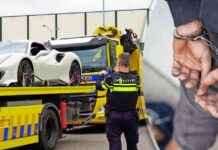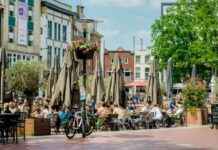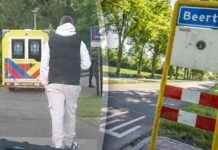The medium-sized entrepreneur calls these moments when he sits in front of his pink safe “eye care”. The door of the 600-kilogram steel cabinet is then wide open and the lighting is switched on. The host makes himself comfortable in the armchair and enjoys the view of his favorite items.
Eight round wooden compartments with luxury watches can be seen in the middle of the cabinet, most of them are Rolex models, Patek Philippe is also on a dial. Every few seconds a compartment will start moving. The automatic watches have to be turned from time to time so that the movement does not stop at some point. Underneath are drawers made of open-pored oak, gold chains and rings.
Everything in the closet is lined with quilted Alcantara, even the inside door with her initials embroidered on it. “It should visually pop” was the customer’s specification for the manufacturer Hartmann, the market leader in Germany. The entrepreneur spent a five-digit euro amount on the safe. Although he likes to show visitors his collectibles, he doesn’t want his name to appear in the newspaper.
The watch collector is not the only one with a safe in the house. The German market for protective cabinets is estimated to have an annual turnover of 200 million euros, with private customers accounting for a third of this. Medium-sized companies dominate the business.
In addition to Hartmann from Paderborn, the major suppliers also include the Essen safe factory, Burg Wächter from North Rhine-Westphalia and Bremer Tresor. There has also been competition from the Chinese group Tristar since it took over the Hessian manufacturer Format Tresorbau. The same applies to all of them: the business is growing.
On the one hand, because of the low interest rates, there is a trend towards investing in tangible assets such as jewelery and watches. On the other hand, the banks are promoting the private purchase of safes by withdrawing from the area and the disappearance of many safe deposit boxes on site.
The average age of buyers is more than 50 years. In order to also appeal to younger customers, safes are not only increasingly individually designed – environmental compatibility is now also an issue.
But this is exactly where the safe has a serious problem, because high levels of carbon dioxide emissions occur during production from steel and concrete. Safes are also not recyclable because the components cannot be separated. Currently they are simply shredded.
But the zeitgeist calls for changes. Sustainable materials, the smallest possible CO₂ footprint in production, as well as dismantling and recycling are important criteria for the development engineers. This also has to do with the EU. Their eco-design guidelines apply to industrial products such as safes. Soon there will probably also be detailed regulations for safes.
Hartmann, founded 150 years ago in East Westphalia, describes itself as a pioneer in environmentally friendly safe construction. The family company has launched the first product in the industry in Germany in which the energy consumption during production is measured. The document cabinet therefore emits around 500 kilograms of carbon dioxide. The Björk model has an eleven percent lower CO₂ value than its predecessor. This is certified by the expert organization Audit Cert from North Hesse.
The main focus here is on the energy consumption in the production of concrete, steel or paint for the document safe. 89 percent of the savings come from using environmentally friendly raw materials, seven percent from production processes and four percent from optimizing transport.
For example, the switch to steel walls from green smelters, which work with renewable energies such as hydrogen, brings a reduction in the CO₂ consumption in the manufacture of the safe.
In addition to Hartmann, the Swedish competitor Gunnibo is also working on such an environmental certification in Europe. In addition, sustainably grown kiri wood from Germany replaces the concrete filling between the two steel walls of the safety cabinet. If someone tried to break out, it would start to burn and smoke – that deters criminals. Inside the cupboard there are wooden shelves made of local birch instead of metal plates.
“There are still no standards for the CO₂ footprint in our industry,” says Markus Hartmann, co-owner and CEO of the family company. That’s why his company initially chose a simple product to start with. The document cabinet has the lowest resistance level and can be insured for values up to 65,000 euros. Weapon cabinets and higher quality safes will follow soon. The prices for safes are also based on the security level.
“We searched for the term eco safe on Google and found zero hits,” says Hartmann. The family company wants to gain a head start. The manager also looks back: “My grandpa would have laughed his head off. My father would have said that we’d see what was going on with the topic. And now we want to get the ball rolling,” says Hartmann.
He is the fourth generation to run the family business. With a turnover of around 22 million euros in Germany and 160 employees, Hartmann sees itself as the market leader in the safes business in Germany. However, most of the production takes place in Poland and Slovenia. The company justifies this with the high proportion of manual work, for example for welding. The safes are then developed and finished in Paderborn.
The medium-sized company’s green safe is currently ten percent more expensive than the previous model. Business customers are more likely to be willing to pay this surcharge than private individuals. For example, if a health food chain does its own eco-balance and keeps the stores’ earnings in sustainable safes instead of traditional safes on-site, this reduces the retailer’s carbon footprint.
However, the topic is also viewed critically among industry experts. “I think sustainability in safes is more of a game,” says Frank von Ostrowski, Chairman of the Safe Technology Association and entrepreneur from Duisburg. “Environmental compatibility is difficult in the high-security area.” He does not want to rule out a climate-neutral safe for the future. But a green energy label for safes can hardly be achieved in the near future. In addition, the head of the association doubts that customers would pay the extra price.
Another trend that the industry had high hopes for has so far hardly caught on: the digitization of safes. Fingerscan locks have long been a matter of course. However, opening the safe remotely using a cell phone – which is technically feasible – has not yet been widely used on the market.
However, additional users of a safe can be added via an app using a code or finger scan. Commercial customers use this, for example, if several employees should have access to the safe. Work is also being done on storing cryptocurrencies or digital, counterfeit-proof works of art, so-called non-fungible tokens. However, the owners could not enjoy them as visually as the watch collector with the pink safe.
“Everything on shares” is the daily stock exchange shot from the WELT business editorial team. Every morning from 7 a.m. with the financial journalists from WELT. For stock market experts and beginners. Subscribe to the podcast on Spotify, Apple Podcast, Amazon Music and Deezer. Or directly via RSS feed.




















